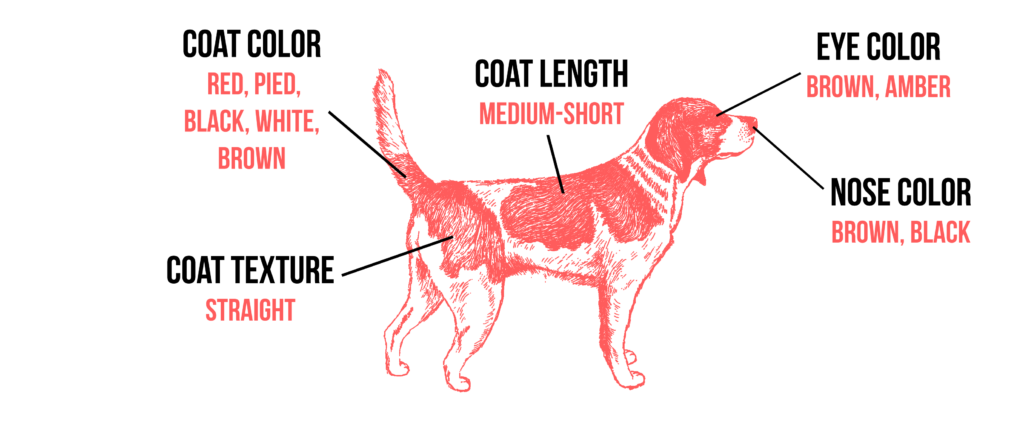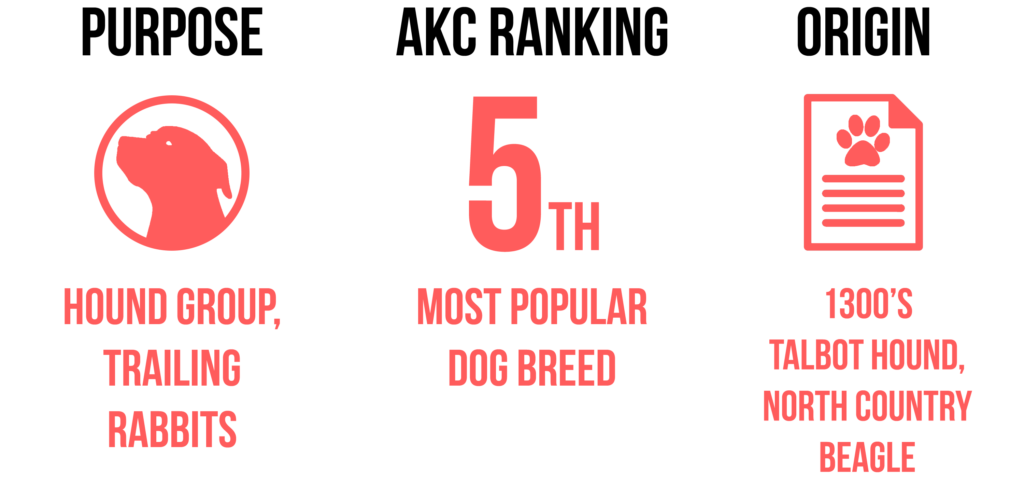
Did You Know?
- Beagles will grow bored if they’re alone inside the house. When outdoors, in the backyard, Beagles will entertain themselves by digging, howling, or attempting to escape.
- Unfortunately, there are those who steal Beagles in order to sell them to research laboratories for experiments. It’s a good idea to keep an eye on your pet when they’re playing outdoors. Microchipping them is also an option.
- Beagles have a long and gentle nature, but can also be stubborn and independent. Take your Beagle to obedience training and make sure the teacher knows how a Beagle’s personality works and that they use food as a reward (as Beagles love treats).
- Food is very important to a Beagle, and that includes its food bowl. Help your children understand that it’s important to respect a Beagle’s personal space when eating. Teach them to never tease their Beagle with food.
- Known to be difficult when housetraining, it’s a good idea to crate train your Beagle. It may take up to a year to really housetrain your Beagle, according to some people.
- Baying is when a dog howls with a deep, prolonged sound, like a hound on the scent. Be prepared to work with your Beagle’s baying, as this is one of the primary reasons Beagles get turned over to rescue groups.
- Because of their nature as scenthounds, Beagles are controlled by their noses. If they smell something enticing or interesting, they will wander off to find the source of the smell.
- Beagles are known to be “chow hounds,” which mean they will overeat if the opportunity presents itself. Make sure you secure your food and manage their food intake in order to avoid weight gain.
- Due to his black and white color, you may not have realized it, but Snoopy from Peanuts is a beagle!
- If you’re looking for a guard dog, keep looking. Beagles are friendly to most people they meet, making them ineffective as guard dogs but great at making friends.
Breed Characteristics
Adaptability

Apartment Adaptability: 4/5
Good for First-Time Owners: 3.5/5
Tolerates Time Alone: 1.5/5
All-Around Friendliness

Family Friendly: 5/5
Dog Friendly: 5/5
Stranger Friendly: 5/5
Health Grooming

Shedding Level: 3/5
Ease of Grooming: 4/5
Average Healthiness: 1.5/5
Trainability

Ease of Trainability: 1/5
Intelligence Level: 4.5/5
Barking and Howling Tendencies: 5/5
Exercise Needs

Active Level: 4/5
Intensity Level: 5/5
Playfulness Level: 5/5
 Overview
Overview
Once you look into a Beagle’s dark brown or hazel eyes, it’s hard not to love him. They have a loving and happy nature, balanced by inquisitiveness, determination, and a love for food. They are not the loudest dogs, but not the quietest either. Beagles have three different types of vocalizations: a baying howl, a bark/growl, and a half-baying howl (which is a cross between a bay and a frantic bark). The latter is usually used when they see their prey or in the early hours of the morning when they think it’s time to wake up.
Beagles are friendly to other animals and strangers alike. Their friendliness is due to Beagles being pack dogs, so getting along with others is in their nature.
Beagles are scent hounds, which means their nose is their most valuable asset. If you think you’ve got a good nose, think again: Beagles have around 220 million scent receptors, whereas humans only have about 5 million. Don’t be surprised, then, to see Beagles with their heads on the ground, looking for any interesting scents to follow.
Beagles became part of the U.S. government workforce when, in 1984, the U.S. Department of Agriculture began using them to sniff out contraband food that was being brought into the U.S. at the L.A. International Airport. The whole thing became a success, as Beagles not only had the ability to identify specific food articles but, due to their small size and friendly nature, didn’t scare people who were afraid of dogs. Known as the Beagle Brigade, packs of Beagles are used in more than 20 international airports today and other points of entry into the U.S.
Although Beagles are currently used for numerous purposes, they are still primarily hunters of small game. Breeders and their pack of Beagles are put to the test in the National Beagle Club’s Institute Farm field trials, which are sanctioned by the American Kennel Club. Similar hunting activities for Beagles can be found throughout the world.
Beagles can easily adapt to apartment living due to their small size and gentle nature. However, owners must be prepared to walk them several times a day, no matter the climate. Beagles are high-energy dogs that need about an hour of exercise a day. If neglected, Beagles can act out and destroy the furniture around them.
History
The Beagle’s origin is as uncertain as his name. Some believe the name could have come from the German word begele, which means “to scold.” Others believe it could have come from the Old English word beag, which means “small.” Other contenders are the French words beugler and beguele, which mean “bellow” and “open throat” respectively. However, the origin is not certain, just like the dog’s history. Keep in mind that breeds, as we know them today, didn’t exist until the 19th century.
It’s reported that Romans could have brought rabbit-hunting hounds with them as they traveled to England and, once there, these hounds were bred with the local hounds. Greek documents that go as far back as 400 B.C. tell us of Beagle-like dogs. Talbot hounds, which are thought to be ancestors to the Foxhound and the Beagle, were reportedly taken to England by William the Conqueror in 1066 during the Norman Conquest.
Beagle-like dogs were very popular in England throughout their earlier years. Glove Beagles, dogs so small that they could be held in a gloved hand, were very popular during the reigns of Edward II (1307-1327) and Henry VII (1485-1509). Singing Beagles were also referenced in documents, known for their bugling voices. Pocket Beagles, standing at only 9 inches tall, were depicted as pointy-nosed and short-legged in paintings. It’s reported that Elizabeth I (1533-1603) kept packs of them. These Pocket Beagles were used for hunting at the time but, due to their rather slow speed, were only used as such for a short period of time.
The English stopped using Beagles to hunt around the 1700’s, when fox hunting became a popular sport and Foxhounds, much larger dogs, became their preferred choice. The Beagle would have headed for certain extinction had it not been for the farmers in Wales, Ireland, and England who kept packs of Beagle around to hunt small game such as rabbits and hares. The modern Beagle is believed to have come from a pack that was established in Essex by Reverend Phillip Honeywood in the mid-1800’s. This pack of Beagles was bred with a focus on hunting skills, not on looks.
Beagles that were both good hunters and attractive were bred by a fellow Englishman named Thomas Johnson. American breeders began importing Beagles from England at around the same time Johnson bred his dogs, all to improve the look on their own dogs. Some were bred to hunt foxes, and so their height was about 15 to 17 inches tall at the shoulder. In America, Beagles were bred to be smaller than their English counterparts so they could hunt small game like rabbits instead of foxes.
In 1880, Willet Randall bred what is known as the “Patch” Beagle in New York. Popular during the 1940’s and 1950’s due to their speed, the Patch Beagles had a white coat with a large tri-colored spot. Currently, if a Beagle has a red and white or lemon and white coat they’re called “Patch” Beagles.
In 1884, the first Beagle specialty club was founded along with the American Kennel Club. The Beagle was one of the first breeds to be registered with the AKC, starting the same year as the club’s founding. In 1916, members of the National Beagle Club purchased over 500 acres in Western Loudoun County, Virginia. Their intent was to have a place specifically for field trials. Today, the National Beagle Club holds many activities on the same property.
Size
 There are two types of Beagle that the American Kennel Club recognizes: the 13-inch tall variety and the 15-inch tall variety. The 13-inch classification is for hounds that stand no more than 13 inches at the shoulder, while the 15-inch classification is for the ones that stand anywhere between 13 and 15 inches at the shoulder. Depending on their individual height, weight ranges between 18 and 30 pounds for Beagles.
There are two types of Beagle that the American Kennel Club recognizes: the 13-inch tall variety and the 15-inch tall variety. The 13-inch classification is for hounds that stand no more than 13 inches at the shoulder, while the 15-inch classification is for the ones that stand anywhere between 13 and 15 inches at the shoulder. Depending on their individual height, weight ranges between 18 and 30 pounds for Beagles.
Appearance
 Any hound color is acceptable for Beagles as far as the breed standard is concerned. Beagles, no matter their coat color, will usually have a white tip on their tails in order to help hunters see them when hunting in tall grass. The most common color among Beagles is the tricolor with a black saddle (around their back). They will have a tan coloring around their heads and around the saddle, with a white chest, legs, and belly. The second most popular coat color is a combo of white and red with an Irish spotting pattern on the legs, face, neck, and the tip of the tail.
Any hound color is acceptable for Beagles as far as the breed standard is concerned. Beagles, no matter their coat color, will usually have a white tip on their tails in order to help hunters see them when hunting in tall grass. The most common color among Beagles is the tricolor with a black saddle (around their back). They will have a tan coloring around their heads and around the saddle, with a white chest, legs, and belly. The second most popular coat color is a combo of white and red with an Irish spotting pattern on the legs, face, neck, and the tip of the tail.
Behavior
Personality
If you want your Beagle to be a well-rounded dog, make sure he’s exposed to various sounds, sights, people, and experiences as early as possible. Early socialization is important for Beagles just like it is for every dog. Beagles are generally sweet and gentle but are also known to misbehave from time to time. Beagles love food rewards, so if you’re looking to help your dog become more obedient (at least for a time), try using treats as a way to shape their behavior.
Children and Other Pets
Beagles will bond with your entire family due to their friendly nature. Like with every dog breed, play dates between children and Beagles should be supervised. They are known to grab hands, whether it’s your children’s or yours, as a form of playfulness. If you don’t like it, you can train your Beagle to avoid this type of behavior. Beagles don’t like being left alone due to their heritage as pack dogs. Having another pet they can play around with, like a dog or a car, can help with their need for companionship.
Health
 It’s important to be aware of possible conditions your Beagle may suffer from, even if they’re lucky enough to never suffer from any of them. The following is a list of conditions that particularly affect Beagles.
It’s important to be aware of possible conditions your Beagle may suffer from, even if they’re lucky enough to never suffer from any of them. The following is a list of conditions that particularly affect Beagles.
Intervertebral Disk Disease
This condition happens when the jelly-like inner layer of intervertebral discs (the vertebral column’s “shock absorbers”) protrudes into the spinal canal and pushes against the spinal cord. The damage caused can range from minimal (neck/back pain) to severe (paralysis, loss of sensation, bowel, and bladder control). It’s important to treat this early on as the damage can be irreversible once it takes place. Surgery is usually done to relieve pressure on the spinal cord, but it may not always be successful.
Hip Dysplasia
A condition that can affect any dog, hip dysplasia is inherited and causes pain and/or lameness on the dog’s rear legs due to the thighbone not fitting snugly into the hip joint. As the dog ages, arthritis can develop. To diagnose the problem, take your dog to the vet and have him X-rayed.
Cherry Eye
This condition is called cherry eye because the gland under your dog’s third eyelid protrudes and looks like a cherry in the corner of their eye. The solution involves your vet removing the gland if it becomes a problem.
Glaucoma
This is an eye disease which can result in blindness due to unusually high pressure in the affected eye, causing damage to the optic nerve. There are two types of glaucoma: primary and secondary. Primary glaucoma is hereditary. Secondary glaucoma is the result of a tumor, inflammation, or injury. Glaucoma will generally affect one eye at a time. Some of the signs include redness in the eye, which can also become teary, squinty, and painful. The front part of the eye will have a whitish/blueish cloudiness and a dilated pupil won’t react to light. Depending on the case, surgery or medication may be the best option, but it won’t always work.
Progressive Retinal Atrophy (PRA)
Detectable years before your dog suffers from the eventual outcome, PRA is a degenerative eye disorder that causes blindness. Because Beagles have a great sense of smell and hearing, they can use their other senses to compensate for their vision loss.
Distichiasis
This condition causes a dog’s eye to get irritated due to an additional row of eyelashes protruding along the edge of the eyelid. If you notice your Beagle is squinting or rubbing his eyes constantly, take him to the vet to see if he’s suffering from this condition. Treatment comes in the form of surgery in which the excess eyelashes are frozen and removed. The surgery is done under general anesthesia.
Epilepsy
Epilepsy in dogs is a neurological condition that is generally inherited. Your dog can suffer from mild to severe seizures that you may not realize are seizures. If you see your dog running frantically as if they were being chased or hiding, they may be suffering from a seizure. Your dog may also fall down and lose consciousness as his limbs become rigid. While it may sound scary, the long-term prognosis is good, for the most part. Make sure you take your dog to the vet to get a proper diagnosis and treatment, as seizures may be caused by other conditions.
Hypothyroidism
Treated with medication and diet, hypothyroidism is a disorder that is presumably responsible for many conditions such as pyoderma hyperpigmentation, epilepsy, obesity, alopecia, and lethargy.
Beagle Dwarfism
Just like humans, dogs can suffer from dwarfism and end up smaller than they usually would be. You may notice other physical abnormalities in your dog, like having extremely short legs.
Chinese Beagle Syndrome (CBS)
Dogs with this condition tend to grow normal, for the most part, but have a wide skull and slanted eyes. They may also suffer from heart problems and toe abnormalities.
Patellar Luxation
This condition, also known as slipped stifles, results in lameness or an abnormal gait (like a skip or hop in their step). It’s present since birth but may not show up until much later in the dog’s life. The condition can also lead to arthritis. There are four grades of patellar luxation, from mild to severe. Grade I, for example, can cause temporary lameness in the joint. Grade IV, on the other hand, can result in the dog having a bowlegged appearance. Cases like this will require surgical repair most of the time.
Maintenance
 Care
Care
Beagles are natural wanderers so it’s important to keep them in a securely fenced backyard or space. Many Beagles escape, due to their curious nature, so it’s a good idea to have them microchipped and wear identification tags so they can be returned to you. Electronic fences may not always work, as a Beagle may push through the momentary shock if they smell something enticing enough. Electronic fences will also not stop other animals from coming into your yard.
Obedience training is a must for Beagles. Make sure you use positive reinforcement and reward them with treats. If you treat them harshly, Beagles will switch off and not listen to you. Beagles are known for being high-energy, so make sure you take them on walks or go jogging with them. If you live in a hunting area, rabbit hunting is also a good idea (but only if you have trained them to come back to you). However, it’s better to wait until they’re 18 months old or older before you take them jogging, due to their bones still developing before that. Beagles are prone to obesity, so if you notice them becoming lazy as they mature, take them out and exercise with them.
Feeding
The recommended amount for Beagles to consume on a daily basis is 3/4 to 1.5 cups of high-quality dry food, divided into two meals. Each dog is an individual, however, so adjust that amount accordingly.
Like it’s been mentioned before, Beagles love food. If you don’t secure your food properly, they will be more than happy to dig their noses into your garbage and pantry if they smell food. When rewarding good behavior, it’s a good idea to give him treats, but give them out sparingly. Beagles don’t need big biscuits to be happy; bite-size ones will do just fine.
Grooming
Beagles are generally clean dogs and frequent baths are not really necessary. They have a smooth, dense double coat that is fortunately resistant to rain. They tend to have thick coats in the winter and shed more during the spring. However, due to their short hair, their shedding is not that noticeable. Brush them about once a week with a medium-bristle brush or a hound glove in order to remove dead hairs and encourage new hair growth.
If you want to prevent gum disease and bad breath in your dog, brush their teeth on a daily basis. Check their ears once a week for any signs of infection or waxy buildup. Because they are drop-eared dogs, infections can take place since air doesn’t circulate well in those areas. Be careful when bathing them or taking them outside and make sure water or oils never enter you Beagle’s ears.
It’s important to accustom your Beagle to grooming from an early age. If you wait too long or have bad experiences, they will not cooperate when it’s grooming time. If you use positive reinforcement during grooming, your Beagle will be more than happy to cooperate. As you groom him, check for any signs of infections (such as inflammation, redness, or tenderness), rashes, and sores. Check his eyes to make sure there’s no redness or discharge.
If your Beagle hasn’t worn their nails down naturally, you will need to trim them once or twice a month. If you don’t feel comfortable doing it, take them to a groomer or vet. Dog toenails have blood vessels in them, so be careful when trimming. If you cut too far, your Beagle will bleed and have a painful experience and the chances of him cooperating in the future will be zero.
Questions
How long do Beagles live?
Beagles have an average lifespan of 10 to 15 years.
What food should not be fed to Beagles?
The following foods will make your Beagle sick and some may even prove fatal, so avoid them at all costs: avocados, cat food, chocolate, coffee, tea, caffeine, and sugarless gum. If you think your dog has eaten something poisonous, call Animal Poison Control at (888) 426-4435.
Is a Beagle a guard dog?
Beagles are scent hounds and good for hunting small game like rabbits and hares. However, they are very friendly and a burglar is as likely to get licked to death by your Beagle as getting attacked by it. Beagles make great pets, but not so good guard dogs.
Resources
Rescue Groups
Beagles are often acquired without any clear understanding of what goes into owning one. The following rescue groups can help you find Beagles in need of adoption or fostering.
Breed Organizations
Top Breeders
The following is a list of the most reputable Beagle breeders of 2017.
- Carolina Beagles
- Mitchell Kennels
- Big Holler Pups
- The Happy Woofer
- Rockwood Beagles
- Short Acre Beagles
- Sundown Beagles
- Jackpot & Kingsbury Hounds
- Scrogham’s Blue Kennel
- Joyful Puppy Tails
Beagle Adults For Sale
If you’re interested in purchasing an adult dog, click on the links below to find adult Beagles for sale.
Beagle Puppies For Sale
If you’re interested in purchasing Beagle puppies, below you will find different online marketplaces that have Beagle puppies for sale.













 Overview
Overview Care
Care